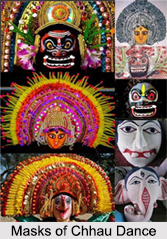 The origin of Chhau dance lies in the Indian states of Odisha and West Bengal. The Chhau dance form of Odisha lacks the mask and instead combines facial expression with body movement and gesture. But the masks of Chhau dance are a part of the traditional and cultural heritage of several districts of West Bengal, namely, Purulia, Medinipur and Bankura. It is known that the Chhau mask of Purulia is registered under Geographical Indications.
The origin of Chhau dance lies in the Indian states of Odisha and West Bengal. The Chhau dance form of Odisha lacks the mask and instead combines facial expression with body movement and gesture. But the masks of Chhau dance are a part of the traditional and cultural heritage of several districts of West Bengal, namely, Purulia, Medinipur and Bankura. It is known that the Chhau mask of Purulia is registered under Geographical Indications.
History of Masks of Chhau Dance
It was under the reign of King Madan Mohan Singh Deo of Baghmundi that the tradition of making Chhau masks came to existence. Thus, the craft of making masks of Chhau dance became an age old tradition in Purulia. The village of Chorida in Purulia is known for its Chhau artists and masks, which are produced by a particular group of people called Sutradhars, who have been engaged in this business for generations.
Theme of Masks of Chhau Dance
The effectiveness, originality and beauty of the Chhau dance are dependent on the Chhau masks. Each mask represents a character from the epics, the Puranas and from mythology. Characters such as the Mahishasur Mardini, Lord Rama- Sita, the fight between Lord Rama and Ravana are depicted on the masks. Other than these, there are also portrayals of Hindu Gods and Goddesses like Goddess Durga, Goddess Lakshmi and Lord Kartikeya, who are always painted in dark yellow or bright orange. Whereas, the white colour is used for Lord Shiva, Lord Ganesha and Goddess Saraswati, along with black or dark blue for Goddess Kali. And the Asuras are painted in black or dark green with a thick moustache, protruding teeth and large eyes. The eyebrows, mouth and eyes are painted to give those special effects and give completeness to the looks of the Chhau dancers.
There are also masks of animal heads like lions, tigers, bears, deer and peacocks, etc along with elements of Santhal couple and Lord Shiva with a hooded snake.
Making of Masks of Chhau Dance
With implementing a few simple ingredients like paper, mud and clay, the masks of Chhau dance are made. There are various stages to the art of Chhau mask making. About 8 to 10 layers of paper is immersed in diluted glue and pasted one after another on a clayey mould and is later dusted with fine ash powder. After this, the facial features are made on the clay and a special layer of mud and cloth is applied on the mask to be sun-dried. The mud is then polished and after another round of sun drying, the layers of cloth and paper are separated from the mould. Vivid and bright colours are used to accentuate the facial features.



















